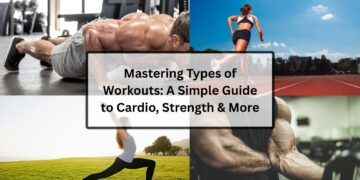In this guide, you will discover the major kinds of exercise, why each type matters, how they help you build physical strength and improve fitness, and how to pick and combine workouts that match your goals. Whether you want to boost endurance, tone your muscles, or just get moving, this blog makes it easy to find the right path.
What Are the Main Types of Workouts?
Why It Matters to Know the Kinds of Exercise
Understanding the different types of workouts is essential for anyone looking to improve their fitness. Each type offers unique benefits and can help you target specific fitness goals, whether it’s weight loss, muscle building, or improving overall health.
How These Types Relate to Your Fitness Goals
The types of workouts you choose will directly impact your fitness results. For example, cardio workouts help improve heart health, strength training builds muscle, and flexibility exercises enhance mobility and prevent injuries.
Type 1 – Cardio Workouts (Aerobic & Anaerobic)
What Counts as Cardio Workouts?
Cardio workouts are exercises that raise your heart rate and improve the function of your cardiovascular system. Common types include running, cycling, swimming, and high-intensity interval training (HIIT).
Key Benefits
Cardio workouts help:
- Improve heart health
- Burn calories and support weight loss
- Increase endurance
- Boost energy levels
Who It’s Best For and How to Start
Cardio is ideal for anyone looking to improve stamina, lose weight, or increase overall fitness. If you’re new to cardio, start with low-impact activities like walking or cycling and gradually build up to more intense workouts.
Common Mistakes to Avoid
- Over training without proper rest
- Skipping warm-ups and cool-downs
- Focusing only on one type of cardio (e.g., only running)
Type 2 – Strength & Muscle Workouts (Building Physical Strength)
What Strength Workouts Include
Strength training involves exercises that target specific muscle groups using weights, resistance bands, or body weight. Common examples include lifting dumbbells, squats, and push-ups.
How Strength Training Improves Your Fitness and Daily Life
Strength training increases muscle mass, boosts metabolism, and improves bone density. It also enhances your ability to perform daily tasks, making everything from carrying groceries to climbing stairs easier.
How Often to Train, Sample Beginner Routine
For beginners, aim to incorporate strength training into your routine 2-3 times per week. A simple plan could include:
- Day 1: Upper body (push-ups, dumbbell curls)
- Day 2: Lower body (squats, lunges)
- Day 3: Core (planks, leg raises)
Myths & Misconceptions
- Myth: Strength training will make you bulky.
- Fact: Strength training can help you get toned and improve muscle definition without excessive bulk, especially if paired with a proper diet.
Type 3 – Flexibility, Balance & Mobility Workouts
What These Kinds of Exercise Include
Flexibility exercises, such as yoga, Pilates, and stretching, improve the range of motion in your muscles and joints. These workouts also enhance balance and posture.
Why They’re Important
Flexibility and mobility exercises help prevent injuries, improve joint health, and enhance overall performance in other workouts, such as strength training and cardio.
How to Fit Them into Your Routine
Integrate flexibility exercises into your routine after strength or cardio workouts as part of your cool-down, or dedicate one day a week to focus on stretching and mobility.
Type 4 – Mixed & Functional Workouts (Circuit, HIIT, Cross-Training)
What Mixed Workouts Are and Why They Matter
Mixed workouts combine multiple workout types (e.g., cardio, strength, flexibility) into a single session. Popular forms include circuit training, HIIT (High-Intensity Interval Training), and cross-training.
How They Combine Cardio + Strength + Flexibility in One Session
Mixed workouts challenge multiple systems of the body at once, promoting overall fitness. For example, a HIIT session might combine sprinting with body weight exercises, giving you both cardiovascular and strength benefits.
Sample Circuit Plan for a Week
Here’s a sample plan for a week of mixed workouts:
- Day 1: HIIT (Cardio + Strength)
- Day 2: Yoga or Pilates (Flexibility + Balance)
- Day 3: Strength training (Lower body + Core)
- Day 4: Rest or light activity (e.g., walking)
- Day 5: Circuit training (Full body)
How to Choose the Right Workout Type for You
Define Your Goal
First, determine your fitness goal. Are you trying to lose weight? Build strength? Improve endurance? Each goal will require different types of workouts.
Assess Your Starting Level, Time Available, Preferences
Consider your fitness level, how much time you can dedicate to exercise, and what types of workouts you enjoy. If you’re a beginner, it’s better to start slow and gradually increase intensity.
How to Combine Different Types for Full-Fitness
A balanced fitness routine includes a combination of cardio, strength, and flexibility exercises. For example, you could do:
- 2 days of cardio (running or cycling)
- 2 days of strength training
- 1 day of flexibility training (yoga or stretching)
- 1 day of rest or light activity
How to Adjust Over Time as You Improve
As you progress, increase the intensity, duration, and variety of your workouts. For example, you could switch from walking to running, or increase the weight you’re lifting.
(FAQs)
- What is the best type of workout if I want to build physical strength?
Strength training exercises like weightlifting, body weight exercises, and resistance training are best for building physical strength. - Can I focus on only one type of workout and still be fit?
While focusing on one workout type is possible, a balanced approach that includes cardio, strength, and flexibility is best for overall fitness. - How many days per week should I do cardio workouts?
Ideally, aim for at least 150 minutes of moderate-intensity cardio per week, or 75 minutes of vigorous-intensity cardio. - Does strength training mean I will become bulky?
No, strength training helps you tone and define your muscles. Bulking up requires specific, intense training combined with a high-calorie diet. - Is mobility or flexibility training really necessary if I already do cardio and strength?
Yes, flexibility and mobility exercises are important for injury prevention, better posture, and improved performance in all other workout types. - How long until I see results from different kinds of exercise?
Most people start to see noticeable results within 4-6 weeks of consistent exercise. However, it depends on the intensity and consistency of your routine.
Final Thought
Each type of workout has its own unique benefits and contributes to a well-rounded fitness routine. The best workout is one that fits your goals, preferences, and lifestyle. Start with one type today, track your progress, and gradually build a routine that incorporates a mix of cardio, strength, and flexibility to achieve total-body fitness.



















